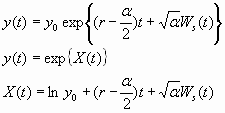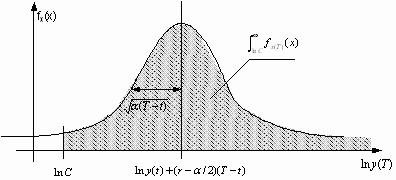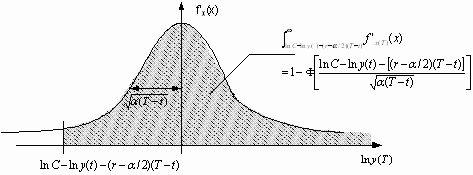We assume a derivative V(y(t),t) that depends on time t and an underlying asset y(t). The derivative is due at time T. The risk less interest rate is represented by r.
![]()
The fair price of the option is the discounted expectation value of the option at the end of the period (T-t).
The asset y(t) will be modeled by a geometric Wiener process as introduced in the previous chapter.

Thereby X(t) denotes the Wiener process with drift.
Let us assume V(y(t),t) is a European call option with the exercise price C than the following transformation holds true:

![]()
![]()
 Thereby fx(x) is the probability distribution function of the Wiener process with drift (b
y-a
/2) which gives the distribution for the logarithmic asset value [ln y(T)] at the time T when the option matures.
Thereby fx(x) is the probability distribution function of the Wiener process with drift (b
y-a
/2) which gives the distribution for the logarithmic asset value [ln y(T)] at the time T when the option matures.
![]() The term
The term
![]() can be transformed into a normal density distribution depending on x with a drift (b
y+a
/2) by separating the term
can be transformed into a normal density distribution depending on x with a drift (b
y+a
/2) by separating the term
which no longer depends on x.
This allows for introducing F (u) the standard distribution function.

In addition we use the fact that the distribution is symmetric and the total integral is one. This means F (-u) equals 1-F (u) which leads us to the Black-Scholes formula:
![]()
![]()
